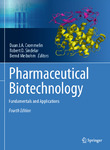| dc.description.abstract | Over the past 25 years, biotechnologically derived drug products have become a
major share of the therapeutically used pharmaceuticals. These drug products include
proteins, including monoclonal antibodies and antibody fragments, as well as antisense
oligonucleotides and DNA preparations for gene therapy. In 2001 already, biotech
products accounted for more than 35 % of the New Active Substances that were
launched in the USA. Twelve out of the twenty-nine approved marketing authorization
applications at the European Medicines Agency (EMA) in 2009 were biotech
products. Drug products such as epoetin-α (Epogen®, Eprex®, Procrit®), abciximab
(ReoPro®), interferons-α (Intron®A, Roferon®A) and interferons-β (Avonex®, Rebif®,
Betaseron®), anti-TNF-α agents (Enbrel®, Remicade®, Humira®), bevacizumab
(Avastin®), and trastuzumab (Herceptin®) are all examples of highly successful biotech
drugs that have revolutionized the pharmacotherapy of previously unmet medical
needs. And last but not least, biotech drugs also have a major socioeconomic
impact. In 2010, fi ve of the ten top selling drugs in the world were biotechnologically
derived drug products, with sales varying between fi ve and eight billion US dollars.
The techniques of biotechnology are a driving force of modern drug discovery
as well. Due to the rapid growth in the importance of biopharmaceuticals and the
techniques of biotechnologies to modern medicine and the life sciences, the fi eld of
pharmaceutical biotechnology has become an increasingly important component in
the education of today’s and tomorrow’s pharmacists and pharmaceutical scientists.
We believe that there is a critical need for an introductory textbook on Pharmaceutical
Biotechnology that provides well-integrated, detailed coverage of both the relevant
science and clinical application of pharmaceuticals derived by biotechnology.
Previous editions of the textbook Pharmaceutical Biotechnology: Fundamentals and
Applications have provided a well-balanced framework for education in various
aspects of pharmaceutical biotechnology, including production, dosage forms,
administration, economic and regulatory aspects, and therapeutic applications. Rapid
growth and advances in the fi eld of pharmaceutical biotechnology, however, made it
necessary to revise this textbook in order to provide up-to-date information and
introduce readers to the cutting-edge knowledge and technology of this fi eld.
This fourth edition of the textbook Pharmaceutical Biotechnology: Fundamentals
and Applications builds on the successful concept used in the preceding editions and
further expands its availability as electronic versions of the full book as well as individual
chapters are now readily available and downloadable though online
platforms.
The textbook is structured into two sections. An initial basic science and general
features section comprises chapters introducing the reader to key concepts at the
foundation of the technology relevant for protein therapeutics including molecular
biology, production and analytical procedures, formulation development, pharmacokinetics
and pharmacodynamics, and immunogenicity and chapters dealing with
regulatory, economic and pharmacy practice considerations, and with evolving new
technologies and applications. The second section discusses the various therapeutic
classes of protein biologics and nucleotide-based therapeutics. | en_US |

